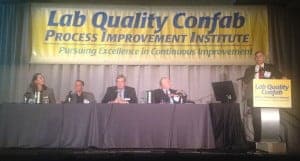
This week, I was able to drop by the annual Lab Quality Confab event since it was being held in here in San Antonio. There were some things I heard during a few presentations about Lean or change management, such as “DMAIC is a Lean tool” and “People hate change… so you have to create consequences for them not changing.” Ugh. I tweeted some of my annoyance with those ridiculous statements.
But, I'll focus on the positive here… an amazing panel discussion that included four very early innovators in the adoption and spread of Lean methods and, more importantly, Lean culture in hospital labs – starting about 10 years ago.
On the panel, pictured from left to right:
- Maureen Harte – one of the early consultants who taught Lean and Six Sigma to labs in the early 2000s (and a foarmer colleague of mine at J&J's ValuMetrix Services group)
- Dr. Richard Zarbo (his blog) – he heads all of the labs at the Henry Ford Health System and a very early adopter in the mid 2000s
- Rick Panning – started adopting Lean in 2003 at Fairview Health Services in Minnesota in 2003
- Leo Serrano – also started adopting Lean in 2003 at Jackson Memorial Hospital in Tennessee, later bringing Lean to the lab at Avera McKennan (case study PDF) and now Broward Health
The moderator, Robert Michel, introduced them and gave them great credit for being brave in going first. Their early Lean Lab success paved the way for broader Lean healthcare initiatives in their hospitals and beyond. These early labs typically reduced turnaround times (cycle time) by 40%, reduced errors by 40%, and improved productivity (without layoffs) by 40%. About Robert, he paid out of pocket (since the organization he worked for wouldn't pay it) to attend one of Dr. Deming's four-day seminars in the early 1990s.
Serrano said “people thought we were crazy” in 2003 until people saw the results. On the consistent theme of employee engagement, Serrano said “Listen to your staff and they will tell you what you're doing wrong.”
Zarbo said “the big gap is employee empowerment…” and that getting everybody involved in continuous learning and continuous improvement requires a “major revolution” in how hospitals are run.
I could do a whole post (and probably will) on Dr. Zarbo's presentation from earlier in the day. During introductory remarks, Zarbo said that he took a physician leader (who is now his CEO) to visit Toyota. Zarbo said it was his own “6th or 7th time at Toyota's training.” I found this really noteworthy because, first, he was learning directly from Toyota, and secondly, how many people continue training beyond their initial “certification” class? Some of the silly things I hear about Lean come from people who have a little training and are, then, overconfident in their knowledge of Lean. Not Dr. Zarbo.
Zarbo talked about the Deming philosophy that's embedded in Lean, saying later that “The respect for people approach is Toyota doing Deming and doing it well.” Zarbo defines Lean as creating a culture of continuous improvement, engaging everyone in a blame-free environment.
Panning talked about how their early goals at Fairview were to improve service and turnaround times, along with reducing errors. Cost reduction came as an end result of that.
Harte described how 12 years ago “nobody” knew of Lean or Six Sigma, or if she would ask at a conference, maybe one hand would go up. We've come a long way.
Zarbo talked about how his lab has trained “thousands” of Henry Ford Health System personnel for free and thousands more who have paid to come from the outside. He said, “Once Lean gets rolling, it's a snowball effect.”
Answering a question about “sustaining projects,” Zarbo said bluntly, “we don't do projects.” He said, “We have people aligned with goals and strategy doing PDSA cycles… the improvement is owned by the people who do the work.” He added they do “audit” things that are the most important for their patients and customers to prevent backsliding. My own commentary is that it's the role of management to “audit” but not in a way that's “policing.” It needs to be a collaborative style that helps people remove barriers to doing things the right way.
Somebody asked the “what's next after Lean and Six Sigma?” question that often pops up. The panel agreed that there's nothing to come next – just continue improving using Lean. Panning said their organization's challenges are changing, so Lean will be more important. Serrano discussed the shift from improving processes to working together with physicians to improve outcomes, using Lean thinking – and this includes reducing the waste of inappropriate orders and test utilization.
After hearing so much “L.A.M.E.” talk, this panel was really refreshing and very inspiring.
Please scroll down (or click) to post a comment. Connect with me on LinkedIn.
If you’re working to build a culture where people feel safe to speak up, solve problems, and improve every day, I’d be glad to help. Let’s talk about how to strengthen Psychological Safety and Continuous Improvement in your organization.









“Nothing to come next”? Hmmmm. I’m thinking there have been a lot of leaders in a lot of industries that probably said the same thing.
I might not have written this well… the question from the audience was about “what comes after Lean and Six Sigma?” as if we’re wrung all we can out of L & SS.
I think there’s still so much room for improvement… organizations (even, say, ThedaCare) haven’t fully transformed their culture and there’s so much room for improvement (especially at organizations that are just doing projects).
I don’t think Lean is a cure all, but I’m fighting against the urge for leaders to move toward what’s new and shiny instead of what’s proven, yet not fully used.
[…] November, I blogged about a panel at the Lab Quality Confab that included Dr. Richard Zarbo from Henry Ford Health System (see their pathology page on Lean). […]
Comments are closed.